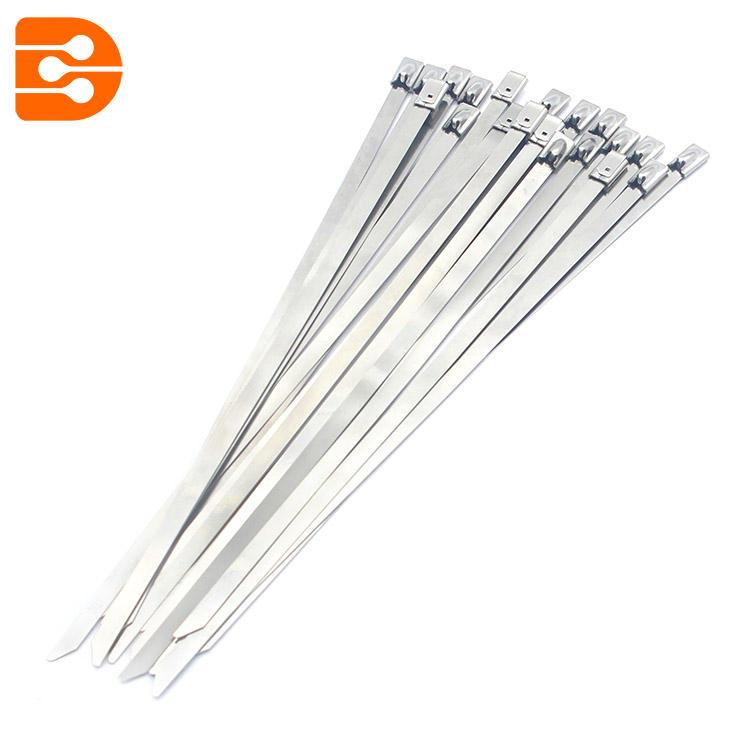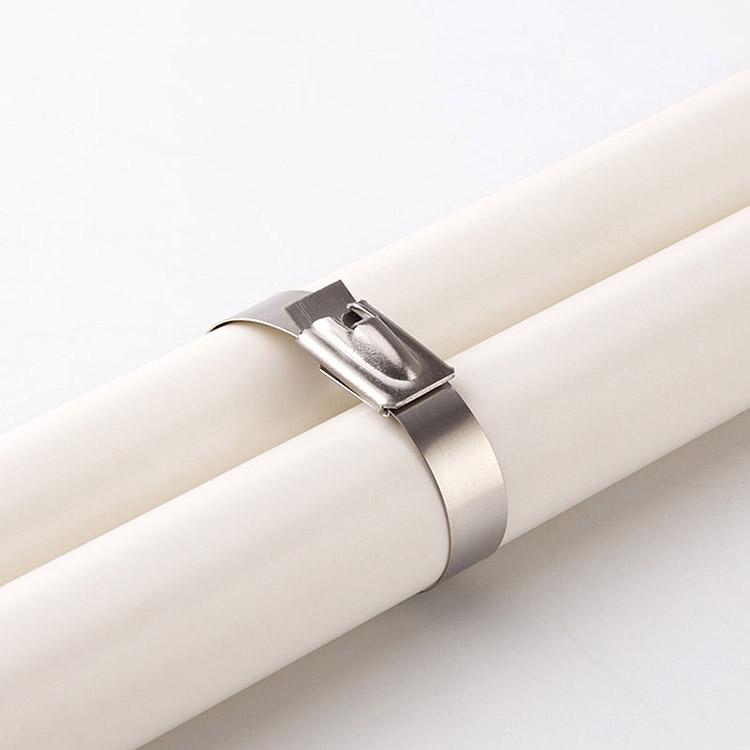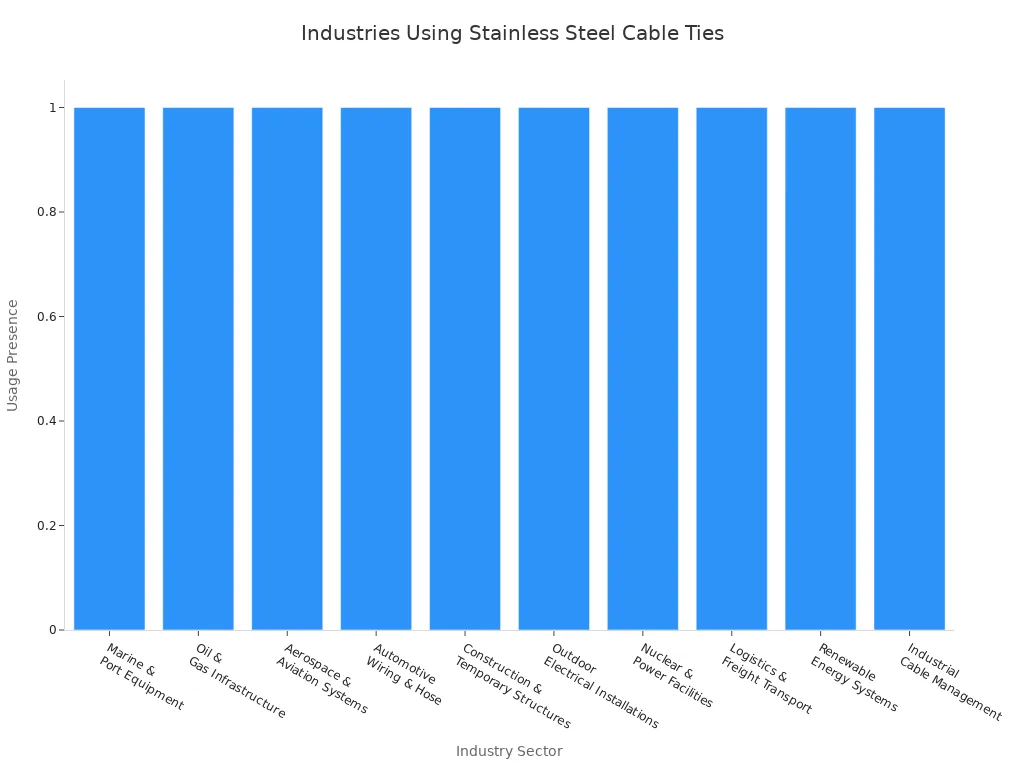
Stainless Steel Ball Lock Cable Tie offers strong resistance against corrosion, chemicals, and extreme temperatures. Workers often see fewer cable failures and faster installations. These ties keep cables secure, which lowers maintenance costs and shortens downtime. Their durability helps industrial sites maintain safety and reliable operations.
Key Takeaways
- Stainless steel ball lock cable ties resist corrosion, chemicals, and extreme temperatures, making them ideal for harsh environments like marine and chemical plants.
- The ball lock mechanism ensures quick, secure fastening that prevents loosening and reduces installation time, improving work efficiency and safety.
- Using these durable cable ties lowers maintenance needs and downtime, saving money over time despite a higher initial cost.
Material Strengths of Stainless Steel Ball Lock Cable Tie

Corrosion and Chemical Resistance
Stainless Steel Ball Lock Cable Tie stands out in harsh environments because it resists corrosion and chemicals. Laboratory and field tests show that these ties can handle salt spray, high humidity, and acidic conditions for long periods. For example, tests in marine settings used salt spray and damp heat to measure corrosion resistance. The results proved that stainless steel ties lose very little weight from corrosion, even after months of exposure. Unlike plastic ties, stainless steel does not swell, crack, or weaken when exposed to acids, alkalis, or solvents. This makes it a reliable choice for chemical plants, marine sites, and other places with harsh chemicals.
Durability in Extreme Temperatures
These cable ties work well in both very hot and very cold environments. They keep their strength and shape from -80°C up to 538°C. This wide temperature range means they perform reliably in deserts, polar regions, and industrial sites with high heat. Plastic ties often fail or become brittle in extreme temperatures, but stainless steel ties remain strong and secure. Their high tensile strength, which can reach over 150 pounds, ensures they hold heavy loads without breaking.
UV and Fire Resistance
Stainless steel ties resist damage from sunlight and fire. Unlike plastic ties, which can degrade under UV rays, stainless steel keeps its integrity outdoors for years. Fire safety tests show that these ties do not melt or burn easily. Their metal construction allows them to meet strict fire protection standards. This makes them suitable for electrical, construction, and transportation industries where fire safety is important.
Ball Lock Mechanism for Secure Fastening

Self-Locking Design and Installation Efficiency
The ball lock mechanism uses a rolling ball inside the buckle. When someone tightens the tie, the ball moves inward and locks the tie in place. This design prevents loosening, even when the tie faces strong tension. Workers find installation quick and easy because the tie locks automatically. The irreversible locking action means cables stay secure without extra adjustments. Compared to traditional nylon ties, this mechanism stops slippage and keeps cables firmly bundled. The Stainless Steel Ball Lock Cable Tie also offers high tensile strength, which helps it hold heavy loads in industrial settings.
Consistent Performance in Harsh Environments
Stainless steel ball lock cable ties perform well in places with high humidity, salt spray, or chemical exposure. Their surface forms a thin chromium oxide layer that protects against corrosion. Electropolishing and passivation treatments make this layer stronger and smoother. These finishing steps help the ties resist pitting and chemical attack. The table below shows how different alloy types and treatments improve mechanical properties and corrosion resistance:
| Alloy Type | Heat Treatment | Key Benefits |
|---|---|---|
| 304/316 Austenitic | Solution anneal, water quench | Good corrosion resistance, high yield strength |
| Duplex (2205) | Two-stage heat treatment | Improved resistance to stress corrosion |
| Super Duplex (2507) | Two-stage heat treatment | Excellent pitting resistance, very high strength |
Tests such as salt spray and crevice corrosion confirm that these ties keep their integrity in tough environments.
Safety and Reduced Risk of Injury
The design of ball lock cable ties helps protect workers during installation and maintenance. Rounded edges and flush cutoffs lower the chance of cuts or scrapes. Ergonomic tools like cable tie guns and automatic cutters make installation safer and easier. These tools prevent over-tightening and ensure smooth edges after cutting. A PVC coating on the tie further reduces sharp edges, making handling safer. Workers experience fewer hand injuries and less strain, which improves overall safety on site.
Practical Benefits in Corrosion-Prone Sites
Lower Maintenance and Downtime
Industrial sites in harsh environments often face frequent cable tie failures. Workers must replace degraded ties, which leads to more maintenance and longer downtime. Stainless steel cable ties solve this problem. They resist corrosion from salt, chemicals, and moisture. These ties do not lose strength or break down, even after years of exposure to tough conditions. For example, in marine and chemical plants, stainless steel ties last over ten years without needing replacement. This long service life means workers spend less time on repairs and more time on productive tasks.
Tip: Using stainless steel cable ties helps teams avoid unexpected shutdowns caused by cable failures.
Extended Service Life and Cost Savings
Stainless steel cable ties offer a much longer service life than plastic ties. Plastic ties often crack or weaken when exposed to sunlight, chemicals, or extreme temperatures. In contrast, stainless steel ties keep their strength and shape for more than a decade, even in the harshest environments. Coatings like epoxy or PVC can add extra protection, making them last even longer in places with strong acids or alkalis.
The table below compares the long-term cost savings of stainless steel cable ties with other fastening solutions:
| Aspect | Details |
|---|---|
| Initial Cost | Higher upfront cost due to quality materials and manufacturing |
| Durability & Performance | Superior strength and resistance to corrosion, chemicals, and temperature |
| Longevity & Compliance | Long lifespan and meets strict safety standards, reducing replacement needs |
| Industrial Applications | Used in industries where reliability and durability are critical |
| Market Trends | Growing use due to easy installation and secure fastening |
| Cost Implication | Fewer replacements and better performance lead to cost savings over time |
Although the initial price is higher, the reduced need for replacements and repairs saves money in the long run. Companies benefit from fewer disruptions and lower labor costs.
Applications Across Key Industries
Many industries rely on stainless steel cable ties for secure and lasting cable management. These ties work well in places where corrosion, heat, and vibration are common. Some of the main industries include:
- Marine and offshore: Secure cables on ships, docks, and oil rigs, resisting saltwater and humidity.
- Oil and gas: Hold pipes and cables in place under high pressure and chemical exposure.
- Aerospace and automotive: Manage wiring and hoses in areas with strong vibrations and temperature swings.
- Construction and outdoor electrical: Fasten fences, lighting, and solar panels exposed to weather and UV rays.
- Power plants and renewable energy: Bundle cables in nuclear, wind, and solar facilities where safety and durability matter.

Note: Quality control tests, such as salt spray and tensile strength checks, ensure these ties meet the demands of each industry.
Stainless Steel Ball Lock Cable Tie stands out as a trusted solution for these sectors. Its resistance to corrosion, fire, and UV rays makes it a top choice for long-term use in challenging environments.
Stainless Steel Ball Lock Cable Tie shows strong performance in tough environments. The table below highlights its reliability:
| Aspect | Details |
|---|---|
| Material | 316 stainless steel |
| Corrosion | Resists salt spray and chemicals |
| Temperature | Works from -80°C to 538°C |
| Strength | Holds up to 300 kg |
Industry reviews note that these ties help teams finish jobs faster and keep cables safe.
FAQ
How do stainless steel ball lock cable ties handle outdoor exposure?
Stainless steel ties resist UV rays, rain, and temperature swings. They keep cables secure in outdoor settings for many years.
Can workers install these cable ties without special tools?
Workers can install these ties by hand. For faster work and smoother cuts, they may use a cable tie gun.
What industries benefit most from these cable ties?
- Marine and offshore
- Oil and gas
- Construction
- Power generation
- Automotive
These industries need strong, long-lasting cable management.
Post time: Aug-25-2025
